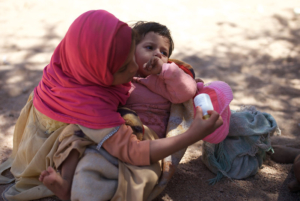Bridging the Gap: Poverty and Maternal Health in Yemen
 Yemen is facing a catastrophic humanitarian crisis. Maternal health issues and extreme poverty have become some of the deadliest threats in the region. According to the United Nations Children’s Fund (UNICEF), one woman and six newborns die every two hours in Yemen due to complications during pregnancy or childbirth. The country’s health care system has been severely compromised by prolonged and intense fighting. Since the conflict escalated between the Saudi-led government coalition and Houthi rebels, maternal mortality rates have skyrocketed.
Yemen is facing a catastrophic humanitarian crisis. Maternal health issues and extreme poverty have become some of the deadliest threats in the region. According to the United Nations Children’s Fund (UNICEF), one woman and six newborns die every two hours in Yemen due to complications during pregnancy or childbirth. The country’s health care system has been severely compromised by prolonged and intense fighting. Since the conflict escalated between the Saudi-led government coalition and Houthi rebels, maternal mortality rates have skyrocketed.
The ongoing conflict has not only destroyed medical facilities but also led to a severe shortage of medical supplies and personnel. As a result, only approximately half of the country’s health facilities are functional and even fewer are equipped to provide adequate maternal and child health services. This scarcity of resources has left millions of women without access to essential reproductive health care, including prenatal check-ups, safe delivery options and postnatal care.
The crisis is further emphasized by widespread food insecurity and malnutrition, which disproportionately affect pregnant women and new mothers. With the economy struggling, many families struggle to afford necessities, let alone specialized medical care. This economic hardship has created a vicious cycle where poverty and poor health outcomes reinforce each other, with devastating consequences for maternal and infant well-being.
Collapsed Health Care System
The conflict has caused a breakdown of Yemen’s health care system. As of 2024, 17.8 million people require health assistance, with one-quarter being women. Among them, 5.5 million of reproductive age, including pregnant and lactating women, struggle to access necessary health services. This is largely due to a shortage of female doctors and nurses, as well as a lack of essential medical supplies. Currently, only one in five functioning health clinics can provide maternal and child health services.
In addition, more than 2.7 million pregnant and breastfeeding women in Yemen are estimated to require treatment for acute malnutrition. Food shortages and insecurity increase the risks of giving birth to newborns with stunted growth and malnourished infants. The lack of medical infrastructure has left millions of women without access to essential health care services.
Economic Impact
The severe economic conditions in Yemen have left 80% of the population struggling to meet basic needs, which directly impacts maternal and infant health through malnutrition and lack of access to care. The economic crisis has worsened the situation for pregnant women and new mothers. The devaluation of the Yemeni Rial and high inflation rates have severely restricted families’ ability to afford nutritious food.
Additionally, the crisis has led to widespread displacement, with 73% of the 4.2 million displaced people being women and children. Despite the Ministry of Public Health and Population’s policy of free access to health care, Yemenis still pay more than 50% of their health expenditures out of pocket.
International Aid
The United Nations Population Fund (UNFPA) has played a crucial role in addressing Yemen’s maternal health crisis by:
- Being the sole provider of life-saving reproductive health services in the country.
- Leading the coordination and provision of women’s reproductive health and protection services nationwide.
- Supporting emergency obstetric and maternal health care at more than 100 health facilities.
- Offering services to prevent and respond to gender-based violence through 36 safe spaces, eight shelters and seven specialized mental health centers.
- Leading a rapid response mechanism in partnership with the World Food Programme (WFP) and UNICEF to provide emergency relief to newly displaced persons.
The European Union (EU) has also been a significant contributor to Yemen’s humanitarian efforts by:
- Allocating more than $130 million in humanitarian funding to address the most pressing needs in the country.
- Contributing nearly $1.6 billion since 2015 to address the Yemeni crisis, including more than $1 billion in humanitarian aid.
- Recognizing 13 humanitarian Air Bridge flights since February 2024 to respond to the urgent health crisis triggered by outbreaks of infectious diseases, including cholera.
- Funding the refurbishment of health centers, such as the Shahir Health Center in Hadramout.
Additionally, the United States Agency for International Development (USAID) has been involved in improving maternal and child health in Yemen. The agency-funded Systems Health and Resiliency Project (SHARP) has made strides in improving maternal and child health services in 14 districts across three governorates. SHARP has reached more than 1.8 million Yemeni people with activities aimed at improving their health. The project has trained and partnered with community midwives, reproductive health volunteers, health facility workers and community members to provide essential health care and support.
Conclusion
Addressing Yemen’s maternal health and poverty crisis requires urgent via coordinated international assistance. Many organizations have contributed to aid and support, but the scale of the issue is demanding and requires a greater response to save lives and break the cycle of poverty and ill health.
– Hannah Ravariere-Moakes
Hannah is based in London, UK and focuses on Politics and Global Health for The Borgen Project.
Photo: Flickr
